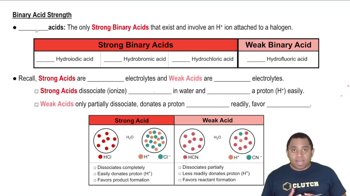Here are the essential concepts you must grasp in order to answer the question correctly.
Acid Strength
Acid strength refers to the ability of an acid to donate protons (H+) in a solution. Stronger acids dissociate more completely in water, resulting in a higher concentration of H+ ions. The strength of an acid is often influenced by its molecular structure, electronegativity of atoms, and the stability of its conjugate base.
Recommended video:
Metal Hydroxides as Acids
Metal hydroxides can exhibit acidic properties, particularly when they are amphoteric, meaning they can act as either acids or bases. In the context of the question, B(OH)3, Al(OH)3, and Ga(OH)3 are metal hydroxides that can donate protons, but their acidic strength varies based on the metal's position in the periodic table and its ability to stabilize the negative charge of the hydroxide ion.
Recommended video:
Hydroxide Ion Concentration Example
Periodic Trends in Acidic Behavior
Periodic trends indicate that acid strength can change based on the group and period of the elements involved. Generally, as you move down a group in the periodic table, the acidic strength of metal hydroxides increases due to the larger atomic size and lower electronegativity, which affects the stability of the hydroxide ion and the ability to donate protons.
Recommended video:
 Verified step by step guidance
Verified step by step guidance


